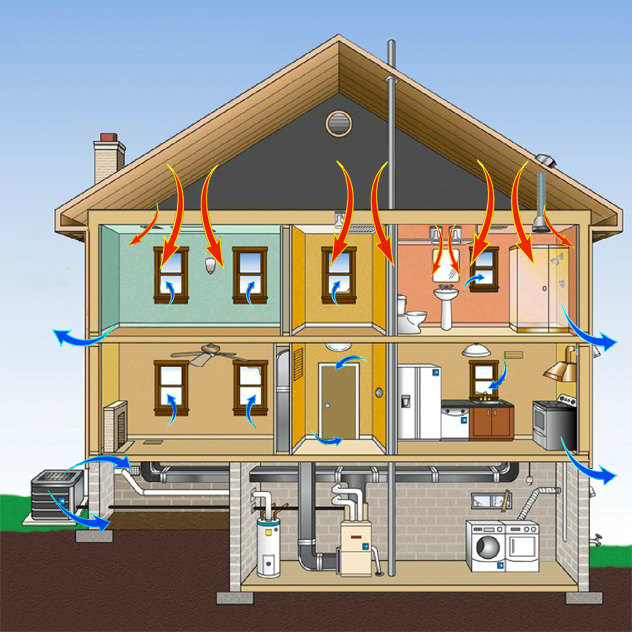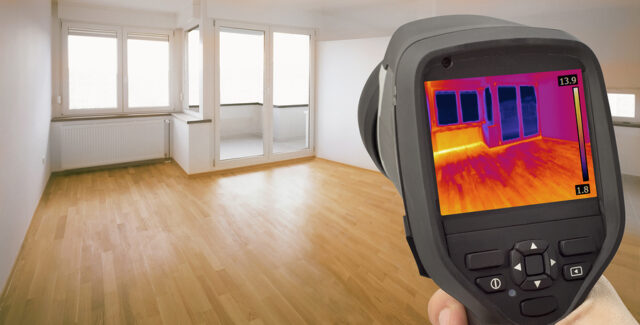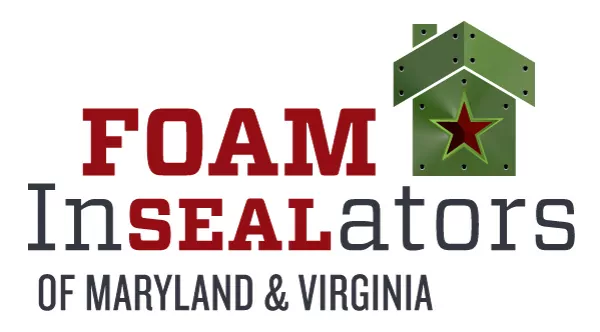Updated November 2023
Do you have vivid memories of visiting an older relative’s home as a child? The second you walked in you were greeted with a big hug, the smell of mothballs, and stale air. At the time, your relative probably didn’t give much thought to how efficiently they were managing their home’s airflow. But if they had known they could save money, save energy, and improve their indoor air quality and comfort with some practical solutions and assessment techniques, chances are they would have jumped at the opportunity.
So, let’s look at how you can improve your Baltimore area home’s airflow for a more comfortable and energy efficient living space.
Understanding Home Airflow
 First, it’s important to understand the concept of airflow and how it works in your home. Essentially, there are two common types of airflow: uncontrolled airflow and controlled airflow.
First, it’s important to understand the concept of airflow and how it works in your home. Essentially, there are two common types of airflow: uncontrolled airflow and controlled airflow.
Uncontrolled airflow creates a “leaky” building that allows air to flow in and out of your home in a random pattern. It works against your home’s energy system, causing more stress on your HVAC system and affecting the quality of your inside air. This erratic airflow is often caused by blocked vents that can hinder the smooth circulation of air and insufficient air sealing that may result in an imbalanced distribution of cold and hot air. Beware that improper airflow can affect the health of you and your family, cause mold growth, spread pollutants, and result in energy loss.
Controlled airflow is managed through mechanical devices (such as your HVAC system, fans, and vents) and allows your home to efficiently ventilate inside air and bring in proper amounts of outside air. This creates a more stable indoor temperature and higher indoor air quality.
Assessing Your Home’s Airflow

You can use a simple tool such as incense smoke to reveal drafts and stagnant air or for a more detailed inspection, consider using infrared cameras to identify temperature variations, indicating potential airflow problems. Once you’ve figured out where the inefficiencies are, you can work to improve your home and eliminate them.
Tips to Improve Airflow
You’ve assessed your home’s airflow and realized it can be better, but what are some practical ways to improve it? Here are some ideas to help circulate air and improve your home’s airflow:
- Service your HVAC system regularly to ensure its optimal performance.
- Use fans strategically to assist in air circulation.
- Regularly clean your air vents and filters to keep clean air flowing.
- Open doors and windows (if it’s safe to do so) to bring in fresh air and allow for steady movement of clean, outside air.
- Install mechanical ventilation to circulate air.
Sealing and Insulation
Aside from blocked vents, gaps and cracks throughout your home are also a major contributor to uncontrolled airflow. These air leaks can be found as small gaps around the doors, windows, light bulbs, and other fixtures in your home and are an open source for conditioned or heated air to escape through.
The best way to eliminate these gaps and keep air from escaping is with air sealing and insulation. Insulation creates a thermal barrier to keep your home warm in the winter, but you need air sealing to eliminate the gaps and cracks. Weatherstripping and choosing to DIY small leaks can be effective, but for optimal results it’s important to install the right insulating and air sealing solution for the different areas of your home.
The ideal way to accomplish both at once is with spray foam insulation. Spray foam is an expanding foam that insulates and air seals in one easy step, helping to control the airflow in your home, reducing your energy costs and providing a comprehensive solution.
Advanced Solutions

Cost-Benefit Analysis
Implementing these changes to enhance your home’s airflow may seem like a large investment, but the long-term savings are noteworthy. When you analyze the cost of improvements versus the potential savings on your energy bills, you’ll reveal a favorable cost-benefit ratio. Real-life examples, such as passive homes around the world, show us how integrating mechanical airflow systems and proper insulation and air sealing can positively impact us in terms of both energy efficiency and financial savings.
Create a More Comfortable Home
By understanding, assessing, and implementing these practical solutions, you and your family can enjoy a more comfortable living space while saving money on each utility bill. Every solution, from smaller (HVAC maintenance, updating to energy efficient windows and using fans), larger (sealing gaps and adding proper insulation with spray foam), and advanced (installing ERVs and HRVs), contributes to a holistic approach to home energy efficiency (and helps prevent your home from smelling like mothballs and stale air).
It’s time to take charge of your home’s airflow, making it work harder for you and improving both your living environment and your bottom line. At Foam InSEALators, we’re here to help you breathe easier by improving your home’s airflow and energy efficiency. Have questions about your home’s ventilation and overall energy efficiency? Contact us today for answers.

